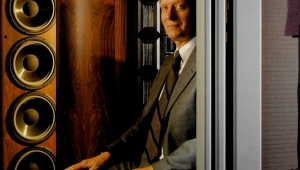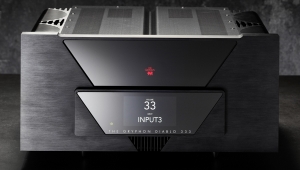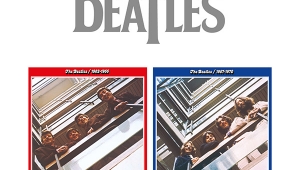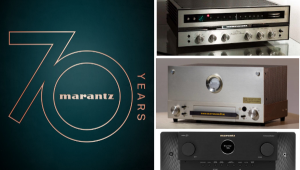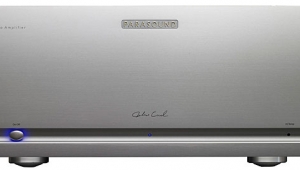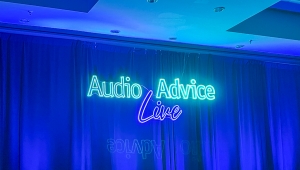| Columns Retired Columns & Blogs |
AES Rolls into SF, Rocks Convention Center
Saturday, September 26, thousands of enthusiastic audio-savvy attendees began swarming through the massive cavern of the Moscone Center's North Hall in San Francisco. They will continue to swarm until late Tuesday, September 29, the last day of the 105th Audio Engineering Society Convention. The convention has attracted hundreds of companies whose products are extravagantly displayed in the huge space beneath the Yerba Buena Gardens. Demonstrations of new products and technologies also take place in smaller rooms off the main floor. Research papers are being presented in meetings throughout the four-day event.
A reconnaissance visit the first day convinced me that covering it all is too big a task for a lone journalist. Jon Iverson will join me here on Monday to divide the labor, and more in-depth coverage will follow. Some general impressions:
Is the pro-audio industry inhabited by a disproportionate number of disreputable-looking hard-core nicotine addicts? It seems that way as you run the gauntlet outside the Moscone Center, where thick, acrid fumes linger around clusters of black-clad smokers skulking near the entrance. But the air is clean inside, and buzzing like a giant hive. San Francisco's downtown convention center is filled to bursting with a dazzling array of professional audio tools and folks eager to use them. Many of the names are familiar to high-end audio fans: Sony, Yamaha, JVC, Shure Brothers, AKG, BeyerDynamic, Manley Labs, NHT, Bryston, Pacific Microsonics, Tannoy, Studer, Crown International, Dolby, Sonic Solutions, Penny & Giles.
Superficially, the biannual AES get-together looks like any other big electronics show, with a major difference: the typical pro-audio concept of music and the musical experience is the exact opposite of the High End's. For high-enders, music is often a vehicle much like the mythical magic carpet---transportive and transformative. This quaint, romantic notion crashes hard against the hypermodern hard-business approach of the pro-audio world, many of whose denizens view music as product and its propagation as cash flow. For them, audio technology isn't a soft art for inducing transcendental reverie, it's an assembly/delivery process serving processed food to a hungry if fickle market. There's an undeniable and disturbing similarity to the automotive industry's production and marketing machine.
This impression is hammered home when you walk around the convention floor, being buffeted by hundreds of competing demonstrations of highly manipulated and very edgy pop music blaring from little self-powered studio monitors, all of them touted as "tonally neutral" and "sonically accurate." There are plenty of products that audiophiles would condemn as heretical---from companies such as Aphex, whose Aural Exciter vocal processors give so many pop voices their synthetic character. Or there's the L2-Ultramixing Mastering Digital Peak Limiter and IDR Dithering Hardware, from Knoxville, Tennessee's Waves. The device is a $1795 processor in a rack-mountable suitcase that lets you make the soft notes hard, the hard notes soft, and can even alter the character of partial notes---like the "pull-off," or small sound a guitarist's finger makes when it releases a string. A demonstration by a Waves engineer purported to show a crowd of onlookers how the L2 could also be used to vary a musical mix for a specific demographic---"classical pop sound," or "ambient house mix," for example---but in the factory-like din the difference was obliterated.
There are, predictably, tons of computer applications, of both the hardware and software varieties. The purposes of many are maddeningly obscure to the naïve observer. Others are simply stupefyingly ominous in their implications---like the "ACID music creation tool" from Sonic Foundry, Inc., of Madison, Wisconsin---software that enables the musically impaired to "create a session" by programming every aspect of an artificial performance. "Click on T for 'tempo'," said the intense, spiky-haired young man demonstrating the contraption, "then use your navigation bar to punch it up or bring it down. Click on K for 'key' and you can change from A to G in midstream . . ." He did so as he spoke, the decorative hardware in his ears, nose, and eyebrows glinting under the bright lights. Like magic, the nervous-energy soundtrack to a shoot-'em-up video game changed keys, like a rock band at full tilt. Thirty or so attendees nodded in rapt attention. Just when you think you're too cynical, the world goes you one better.
Not all at AES is quite so blatantly soulless. Some demonstrations are simply audacious---like Meyer Sound's MP series amplifier, hard at work in an industrial humidity chamber, where the temperature is maintained at almost 100°F and the moisture is a suffocating 95%. "This amp has been running continuously for eight days," reads a sign on the chamber. Try that with your single-ended triode sometime. Meyer Sound prides itself on making products that can endure the withering conditions of tropical climates.
The climate of the recording environment is addressed in no uncertain terms by Acoustic Sciences Corporation, a company known to audiophiles for its Tube Traps. ASC is showing its "Attack Wall" acoustic treatment, a portable, modular system for recording studios or remote locations. A group of teal-colored cylindrical traps is arrayed around a mixing board to create a protected area in a high-SPL situation---like battlefield sandbags stacked around a machine-gun nest. Hyped as the "dead end of an LEDE listening environment," the system might have potential for speaker and amplifier designers as well as hi-fi hobbyists.
Analog isn't dead. There are plenty of non-digital or minimally digital products on display, too---like Solid State Logic's awesome SL-9500 mixing console, a multitrack monstrosity so large it requires at least three engineers to operate it. Billed as the "Ultimate Analogue Console," the audio and video mixer more than hints at a little-known controversy rocking the pro-audio realm: the ongoing religious war between analog and digital.
The controversy is not merely a matter of bickering among audiophiles. Whole cults of analog-only musicians, recordists, and studios have sprung up in a backlash against the digital revolution. Judging by the number of analog products on display, including several massive multitrack recorders and their requisite mixing boards, analog is going strong and shows no signs of impending mortality. An industry group calling itself the "Analog Option Coalition" is hosting what it calls a "town hall meeting on the future of analog" Monday afternoon at the ANA Hotel. We'll be there for a blow-by-blow report.
Ahoy, pirates: for sheer industrial efficiency, you can't do better than MediaForm's CD replicators. Looking more like office equipment than recording-studio gear, the machines are available with as few as one or as many as 64 disc drives. Professional disc compilers---or serious hobbyists---should look no further than their nearest MediaForm distributor. The machines, which have an "audio track extraction feature" that allows duplication of tracks from several masters, run at several times normal speed, copying a 74-minute disc in 18 minutes.
There are many objects and inventions of exquisite beauty on display, and I'm not referring to the many pretty-boy musicians in attendance, or any of several well-out-of-the-closet transvestites prowling the floor. It's the microphones that really grabbed me. Some of them are heartbreakingly beautiful. Retro is in, and microphone manufacturers are pursuing the trend with a vengeance. Neumann's TLM 103 large-diaphragm mike is a stunner. This cardioid for recordists on a budget rolls off smoothly below 50Hz, has a slight rise above 5kHz, and is said to be excellent for vocals. The "Elastic Suspension" (or shock-mount accessory) is a really clever contrivance that must be seen to be fully appreciated. AKG, now a Harman International company, is hyping its C 12 VR. The classic vacuum-tube microphone is an elegant gold-capped cylinder in British racing green. Its twin diaphragms permit the selection of up to nine different polar patterns. Inside the cylinder are gain adjustment and amplification circuitry built around a shock-mounted 6072 vacuum tube, the same type as used in the original C 12.
Wes Dooley's Audio Engineering Associates of Pasadena, CA, has entered the market with microphone housings that are replicas of old RCA broadcast microphones, which they have duplicated down to the logo. AEA also makes a wide array of microphones and accessories. Ten-year-old Conneaut Audio Devices offers another impressive mike collection, including the VSM-1 tube condenser microphone at what it calls a "very aggressive price point." At the other end of the spectrum is the $5500 near-legendary Manley Reference Gold, a beauty that engineer Michael Cooper calls unbeatable for image size and warmth. Manley Labs is one of the few companies with equal footing in the parallel worlds of pro audio and high-end playback. Surrounded by a full line of her products (I didn't know there were so many) and a clique of admirers, tube diva EveAnna Manley was holding court in a black lurex dress.
But the loveliest things on the AES main floor were the creations of Baltic Latvian Universal Electronics (acronym: BLUE), a Sherman Oaks, CA-based company that builds all its products in the former Soviet republic. Its microphones are stunning examples of Machine Age industrial art, deserving of a place of honor at San Francisco's Museum of Modern Art just across the street. "Do they sound as good as they look?" I asked BLUE founder and jazz musician Skipper Wise. "Better than," he laughed. Could I afford it, I would buy the whole product line and display it as sculpture. "The Ultimate in Quality," states BLUE's product literature---a phrase that, in this case, probably isn't hyperbole.
The onslaught of electronics gradually wears you down at such gatherings, and I began wishing for live music---a wish that was soon fulfilled in the EV X-Array Install/Merlin signal processor room, where Wild Mango, a wonderful five-woman, two-man salsa/jazz group, had a packed audience enthralled. All their voices and instruments were amplified through the EV X-Array system. I must admit it sounded quite good---very low distortion and surprisingly transparent---but I couldn't help wondering how much better the performers might sound without electronics at all. Perhaps that little bit of doubt is the real difference between high-end lunatics and pro-audio pragmatists. Reality---an admittedly amorphous concept---is still our reference.
- Log in or register to post comments
